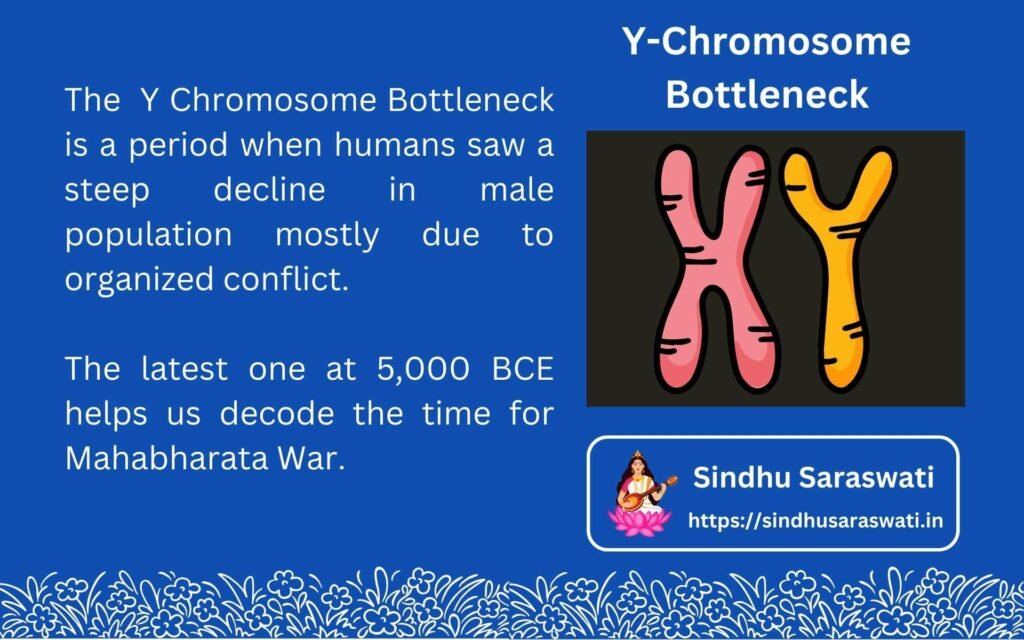The Y Chromosome Bottleneck are periods of mass extinction of Y Chromosomes from the earth, possibly due to war, violence, or purges. The bottleneck has been scientifically proven and is used by researchers and historians to describe a period of historical violence and near-extinction events in Human History and Anthropology.
Two Y Chromosome Bottlenecks have been prominently featured in several research papers. The larger Y Chromosome Bottleneck was around 5000 BCE (Mahabharat Bottleneck) when the male to female ratio dropped to 1:17. The second bottleneck was around 75,000 BCE (Toba Bottleneck) when the human population dropped to less than 10,000 individuals.
What is a Y Chromosome Bottleneck?
A Y Chromosome Bottleneck is an event in human history (and other animals) where there is a shortage of Y Chromosomes (male chromosomes) in the human gene pool. The reason is most widely accepted as due to mass warfare and violence, as throughout history, warfare has been dominated by men.
After such violent periods, generally, there is a period where the number of males is far lesser than the number of females. This leads to a lower diversity in the male gene pool, which leaves its permanent marks on generations to come.
In the past, the “Mahaharat Bottleneck” saw the male-to-female ratio drop to 1:17, i.e., for every 1 male, there were 17 females.
One such recent event in modern history is the post world war social impact on Russia. In the war, it is believed that around 80% of Russian males perished, which led to a skewed ratio between males and females. This led to a lower Y Chromosome gene pool.
List of Y Chromosome Bottlenecks
It is highly likely that there are more Y Chromosome Bottlenecks in history, but for humans, two bottlenecks stand apart from others. The first and the nearest is one at 5,000 BCE, and the second and a more distant one at 75,000 BCE.
5,000 BCE: The Mahabharat Bottleneck
The closest bottleneck happened around 5000 BCE, most probably due to war, and the global male population suffered a massive shrink. This shrink brought the ratio between male-to-female at 1:17.
Historically, anthropologically, and genetically, given sufficient time, the male-to-female ratio in any society or the world (as a whole) remains around 1:1.
Organized conflict (war, raids, battle) emerges as the sole reason for this bottleneck because it selectively kills a much larger population of males, which have been historically the dominant gender affected by war-related violence. The reason this global conflict appears to be organized is that there couldn’t be any other plausible reason for such a large and gender-specific mass extinction.
Nilesk Oak terms this Y Chromosome Bottleneck as the “Mahabharat War”, which appears to be the most probable case because around this time (range -1000 years to +1000 years), there appear to be no other historical records of civilization except Sindhu Saraswati and the early Sumerians. Egyptians would still take around 1000 years above the upper limit (i.e., till 3100 BCE) to consolidate their lands.
75,000 BCE to 60,000 BCE
Another Y Chromosome Bottleneck existed between 75,000 BCE to 60,000 BCE, which resulted in a similar gene pool bottleneck but on a much smaller scale to the most recent one (Mahabharat Bottleneck).
It is assumed that the human population may have shrunk to a range of 3000 to 10,000 individuals at that point.
Reason For 75,000 BCE Bottleneck
This bottleneck, too, was probably caused by conflict, which is the only gender-selective mass extinction event.
Though many researchers still believe that the climate change caused by the Toba superexplosion may have caused this bottleneck, yet it is hard to believe this theory because a global catastrophic event would have impacted males and females alike, in which, a bottleneck is unlikely.
Another likely scenario is that the Toba Superexplosion might have created food shortages that led to violent conflicts and organized raiding parties. Till this period, it was proven that humans could organize themselves in smaller groups (around 50). The need for food might have forced them to raid other groups, and in this process, the limited number of humans could have initiated a wide violent event.

